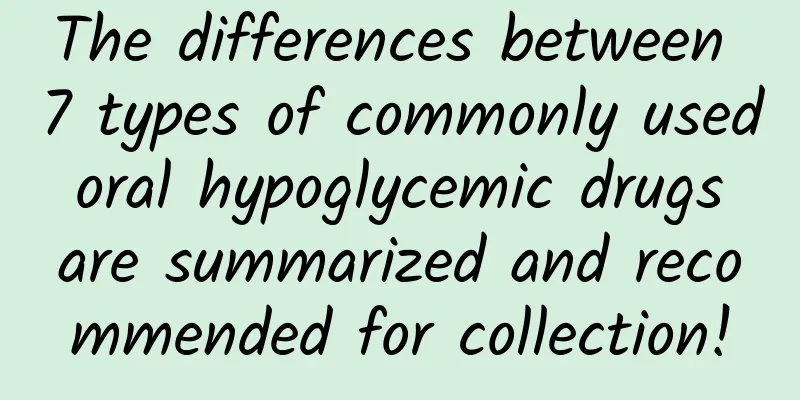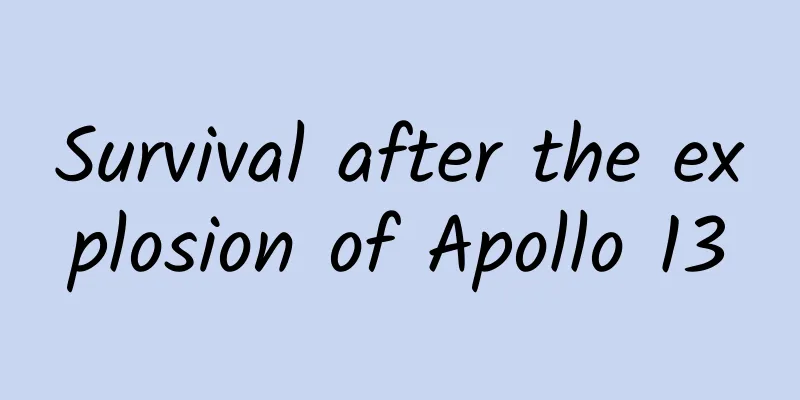The differences between 7 types of commonly used oral hypoglycemic drugs are summarized and recommended for collection!

|
Type 2 diabetes is a common chronic disease that seriously affects the quality of life of patients. Oral hypoglycemic drugs are one of the important means of treating type 2 diabetes. However, faced with a large number of oral hypoglycemic drugs, how to choose the right drug is a challenge faced by doctors and patients. 1. Types of oral hypoglycemic drugs There are currently seven types of oral hypoglycemic drugs commonly used in clinical practice. l Biguanides: can increase glucose utilization and insulin sensitivity. l Sulfonylureas: They lower blood sugar by stimulating pancreatic β cells to secrete insulin. l Meglitinides: can simulate the physiological secretion of insulin. l Thiazolidinediones: can enhance insulin sensitivity. l α-Glucosidase inhibitors: can delay the absorption of carbohydrates. l Dipeptidyl peptidase-4 (DPP-4) inhibitors: can reduce the inactivation rate of incretin hormone and increase its blood concentration. Sodium-glucose cotransporter-2 (SGLT-2) inhibitors: They reduce the renal reabsorption of glucose by inhibiting SGLT-2 activity. 2. Applicable populations and representative drugs of different oral hypoglycemic drugs Biguanides: Suitable for most patients with type 2 diabetes, especially overweight patients. Representative drug: Metformin. Sulfonylureas: Suitable for patients with pancreatic islet function, but prone to hypoglycemia. Representative drugs: gliquidone, gliclazide, glibenclamide, glipizide, glimepiride, etc. Meglitinides: Suitable for patients with high blood sugar after meals. Representative drugs: repaglinide, nateglinide. Thiazolidinediones: Suitable for patients with significant insulin resistance. Representative drugs: rosiglitazone, pioglitazone. α-Glucosidase inhibitors: Suitable for patients whose main diet is carbohydrates. Representative drug: Acarbose. DPP-4 inhibitors: suitable for elderly patients with type 2 diabetes. Representative drugs: sitagliptin, saxagliptin, vildagliptin. SGLT-2 inhibitors: Suitable for patients who cannot achieve satisfactory blood sugar control through diet and exercise or who are intolerant to metformin. Representative drugs: dapagliflozin and empagliflozin. 3. Advantages and disadvantages of different oral hypoglycemic drugs 1. Biguanides Advantages: In addition to its ability to effectively lower blood sugar, metformin can also reduce body weight, blood pressure and blood lipids, has cardiovascular protection, and can significantly improve long-term prognosis. It is the first choice for overweight or obese diabetic patients. It is safe and will not cause hypoglycemia when used alone. It is cheap and cost-effective. Disadvantages: Gastrointestinal reactions are common, and long-term use may affect the absorption of vitamin B12. Patients with heart failure, hypoxia, severe liver and kidney dysfunction should not use it to prevent lactic acidosis. 2. Sulfonylureas Advantages: Outstanding efficacy, low price, first-line medication for type 2 diabetes, no adverse effects on cardiovascular system, and no cancer risk. Disadvantages: It is easy to cause hypoglycemia and weight gain. Some patients may experience adverse reactions such as skin allergic reactions and leukopenia. Secondary failure may occur during use. For the elderly and those with mild to moderate renal insufficiency, it is recommended to take short-acting sulfonylurea drugs that are excreted through the bile duct, such as gliquidone. 3. Meglitinides Advantages: The outstanding advantage is that it can simulate the physiological secretion of insulin during meals, effectively reduce postprandial hyperglycemia and is not prone to hypoglycemia. It has little effect on body weight and is called a "mealtime blood sugar regulator". It can be used in combination with other types of oral hypoglycemic drugs and basal insulin. It can still be used in patients with mild to moderate renal impairment. It can be taken at mealtime, which is convenient and flexible, and has good patient compliance. It is more suitable for patients with irregular mealtime or elderly patients. When sulfonylurea drugs fail, glinides can still be effective. Disadvantages: High price, improper use may cause hypoglycemia. 4. Thiazolidinediones insulin sensitizers Advantages: It does not stimulate insulin secretion, but exerts its glucose-lowering effect by enhancing tissue sensitivity to insulin. This type of drug is suitable for type 2 diabetes, impaired glucose tolerance and metabolic syndrome. It can be used in combination with biguanides, sulfonylurea drugs or insulin to further improve blood sugar control. It will not cause hypoglycemia when used alone. Disadvantages: Increased risk of heart failure, contraindicated for patients with heart function above level 3. Use with caution in elderly patients over 65 years old. Slow onset of action, can lead to water and sodium retention, edema and slight weight gain. Bladder cancer patients or patients with a history of bladder cancer should avoid using pioglitazone. 5. α-Glucosidase inhibitors Advantages: It has a definite blood sugar lowering effect, mainly acts locally in the intestines, only 2% is absorbed into the blood, there are few systemic adverse reactions to the liver and kidneys, it does not increase weight or can reduce weight, this drug alone does not cause hypoglycemia, it has a protective effect on the cardiovascular system, and is suitable for elderly diabetics and patients with renal impairment. It is also the only hypoglycemic drug in China and abroad that has the indication for treating impaired glucose tolerance (blood glucose level 2 hours after a meal is between 7.8 and 11.0 mmol/L). Disadvantages: Since this type of drug hinders the decomposition and absorption of carbohydrates in the intestine, it prolongs the retention time of carbohydrates, thus increasing the gas production by bacterial fermentation. Some patients experience gastrointestinal reactions such as abdominal distension and increased flatulence when first using it. It is contraindicated for patients with gastrointestinal dysfunction, pregnant women, lactating women and children. Note that combined use with other hypoglycemic drugs may cause hypoglycemia, and once it occurs, glucose should be used to correct it. Eating starchy foods is ineffective. 6. DPP-4 inhibitors Advantages: Increases endogenous GLP-1 levels and improves pancreatic α and β cell function. It has the advantages of definite glucose-lowering efficacy, low risk of hypoglycemia, no weight gain, no gastrointestinal reactions, and high safety and tolerability. Oral administration, once a day, with good patient compliance. Disadvantages: DPP-4 is a pleiotropic enzyme, and its inhibitors prolong the effects of hormones such as growth hormone-releasing hormone, neuropeptide Y, and substance P, and may produce adverse reactions such as neurogenic inflammation, increased blood pressure, and immune response. It is expensive and has not yet been included in medical insurance in my country. 7.SGLT-2 inhibitors Advantages: SGLT-2 inhibitors rarely cause hypoglycemia and are beneficial for improving body weight and blood pressure. Oral tablets, once a day, with good compliance. Disadvantages: It may be related to nasopharyngitis, fungal infection and genitourinary system infection. The safety of long-term use needs further observation. Choosing the right oral hypoglycemic drug is crucial for blood sugar control in patients with type 2 diabetes. Doctors should consider the patient's blood sugar level, pancreatic islet function, weight, comorbidities and other factors to develop an individualized treatment plan. At the same time, patients should also maintain good compliance, monitor blood sugar regularly, and work together to lower blood sugar. |
<<: Regarding solar flares, all your concerns are addressed at once
>>: Deadly drowning! The number one killer of children! How to identify the early signs of drowning?
Recommend
Xinyi SEO Training: What are the common ways to obtain external links?
SEOers who are engaged in website optimization wo...
Four channels for APP to recall users: EDM, Push, SMS, and public account
The author of this article will share with you ho...
The transition from developer to manager
[[144435]] The path to advancement for technical ...
Cool fact: The cotton swab used for nucleic acid testing is not actually a cotton swab!
Audit expert: Gu Haitong Deputy Chief Physician, ...
New media operations: promotion and new customer acquisition
The four core goals of operations: attracting new...
My understanding of user activation and practical communication
Activation is to allow users to use the core func...
China Association of Automobile Manufacturers: A brief analysis of the sales of key enterprise groups in the automobile industry from January to July 2023
According to statistics and analysis by the China...
Android P hands-on: The biggest upgrade in a decade, everything you want to know is here
In March, Google released the developer preview o...
Say goodbye to information asymmetry and restore the true truth about mobile phone repairs!
Some time ago, Ms. Wang from Wuhan repaired her m...
Hunan Satellite TV takes back the video broadcasting rights: digging a hole for itself?
On May 8, Hunan TV announced that it would no lon...
Domestic violence doesn’t just mean hitting someone! How to protect yourself when you encounter domestic violence?
Mixed Knowledge Specially designed to cure confus...
What impact will the major App Store revision have on Apple’s ecosystem?
At the WWDC 2017, which lasted more than two hour...
Regarding the "system update" of mobile phones, is it really necessary to upgrade? Let's take a look at the pros and cons
On weekdays, your phone will pop up a reminder ab...
Who retires satellites? Space tugs!
In almost every harbor, we can see a strange kind...
Peach butt training course collection
Peach butt training teaching collection course re...









